-
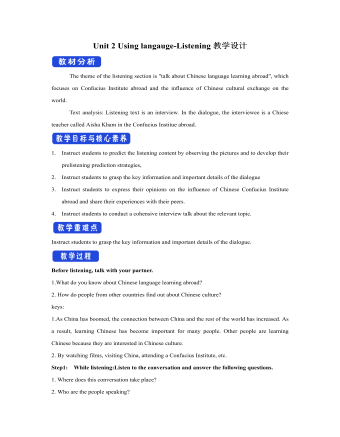
新人教版高中英语选修2Unit 2 Using langauge-Listening教学设计
? B: Absolutely! Getting involved with Chinese cultural activities there definitely helped a lot. I got to practice my Chinese on a daily basis, and I could learn how native Chinese speakers spoke.? A: What do you feel is your biggest achievement?? B: Learning Chinese characters! I have learnt about 1,500 so far. When I first started, I didn't think it was even going to be possible to learn so many, but now I find that I can read signs, menus, and even some easy newspaper articles.? A: What are you most keen on?? B: I've really become keen on learning more about the Chinese culture, in particular Chinese calligraphy. As I have learnt Chinese characters, I have developed a great appreciation for their meaning. I want to explore Chinese characters by learning how to write them in a more beautiful way. ? A: Finally, what do you want to say to anyone interested in learning Chinese?? I have really become keen on learning more about the Chinese culture, in particular Chinese Calligraphy. As I have learnt Chinese character, I have developed a great appreciation for their meaning. I want to explore Chinese characters by learning how to write them in a more beautiful way.? A: Finally, what do you want to say to anyone interested in learning Chinese?? B: I'd say, give it a shot! While some aspects may be difficult, it is quite rewarding and you will be happy that you tried.? A: Thanks for your time. ? B:You're welcome.

新人教版高中英语选修2Unit 3 Using langauge-Listening教学设计
1. How is Hunan cuisine somewhat different from Sichuan cuisine?The heat in Sichuan cuisine comes from chilies and Sichuan peppercorns. Human cuisine is often hotter and the heat comes from just chilies.2.What are the reasons why Hunan people like spicy food?Because they are a bold people. But many Chinese people think that hot food helps them overcome the effects of rainy or wet weather.3.Why do so many people love steamed fish head covered with chilies?People love it because the meat is quite tender and there are very few small bones.4.Why does Tingting recommend bridge tofu instead of dry pot duck with golden buns?Because bridge tofu has a lighter taste.5 .Why is red braised pork the most famous dish?Because Chairman Mao was from Hunan, and this was his favorite food.Step 5: Instruct students to make a short presentation to the class about your choice. Use the example and useful phrases below to help them.? In groups of three, discuss what types of restaurant you would like to take a foreign visitor to, and why. Then take turns role-playing taking your foreign guest to the restaurant you have chosen. One of you should act as the foreign guest, one as the Chinese host, and one as the waiter or waitress. You may start like this:? EXAMPLE? A: I really love spicy food, so what dish would you recommend?? B: I suggest Mapo tofu.? A: Really ? what's that?

新人教版高中英语选修2Unit 4 Learning about Language教学设计
This section guides students to pay attention to the typical context of vocabulary use, helps students accumulate vocabulary around the key vocabulary of this unit, and uses the learned words and word chunks in different contexts to deeply understand their meaning and usage, so as to achieve the purpose of review and consolidation.The teaching design activities aim to guide students to pay attention to the typical context in which the target vocabulary is used, as well as the common vocabulary used in collocation, so that students can complete the sentence with correct words. In terms of vocabulary learning strategies, this unit focuses on cultivating students' ability to pay attention to collocation of words and to use word blocks to express meaning.For vocabulary learning, it is not enough just to know the meaning of a single word, but the most important thing is to master the common collocations of words, namely word blocks.Teachers should timely guide students to summarize common vocabulary collocation, such as verb and noun collocation, verb and preposition collocation, preposition and noun collocation, and so on.1. Guide students to understand and consolidate the meaning and usage of the vocabulary in the context, 2. Guide the students to use the unit topic vocabulary in a richer context3. Let the students sort out and accumulate the accumulated vocabulary, establishes the semantic connection between the vocabulary,4. Enable students to understand and master the vocabulary more effectivelyGuiding the Ss to use unit topic words and the sentence patterns in a richer context.

新人教版高中英语选修2Unit 4 Reading for writing教学设计
假定你是英国的Jack,打算来中国旅行,请你给你的中国笔友李华写一封信,要点如下:1.你的旅行计划:北京→泰山→杭州;2.征求建议并询问他是否愿意充当你的导游。注意:1.词数80左右(开头和结尾已给出,不计入总词数);2.可以适当增加细节,以使行文连贯。参考词汇:故宫 the Forbidden City;泰山 Mount TaiDear Li Hua,I'm glad to tell you that 'm going to visit China.First,I am planning to visit Beijing,the capitalof China,where I am looking forward to enjoying the Great Wall,the Forbidden City and somebeautiful parks.Then I intend to go to visit Mount Tai in Shandong Province.I've heard that it is one ofthe most famous mountains in China and I can't wait to enjoy the amazing sunrise there.After that,I amalso going to Hangzhou.It is said that it is a beautiful modern city with breathtaking natural sights,among which the West Lake is a well- known tourist attraction.What do you think of my travel plan? Will you act as my guide? Hope to hear from you soon.

新人教版高中英语选修2Unit 4 Using langauge-Listening教学设计
The theme of the listening section is " talking about scenery and culture along a journey."The part is designed to further lead the students to understand Canadian natural geography and social environment, and integrated into the cultural contrast by mentioning the long train journey from Beijing to Moscow routes. On this basis, the part activates students related travel experience, lets the student serial dialogue, guides the student to explore further the pleasure and meaning of the long journey, and Chinese and foreign cultural comparison.The part also provides a framework for the continuation of the dialogue, which is designed to provide a framework for students to successfully complete their oral expressions, and to incorporate an important trading strategy to end the dialogue naturally.1. Help students to understand and master some common English idioms in the context, and experience the expression effect of English idioms.2. Guide the students to understand the identity of different people in the listening context, and finish the dialogue according to their own experience.3. Instruct the students to use appropriate language to express surprise and curiosity about space and place in the dialogue, and master the oral strategy of ending the dialogue naturally.1. Instruct students to grasp the key information and important details of the dialogue.2. Instruct students to conduct a similar talk on the relevant topic.

新人教版高中英语选修2Unit 5 Learning about Language教学设计
The purpose of this section of vocabulary exercises is to consolidate the key words in the first part of the reading text, let the students write the words according to the English definition, and focus on the detection of the meaning and spelling of the new words. The teaching design includes use English definition to explain words, which is conducive to improving students' interest in vocabulary learning, cultivating their sense of English language and thinking in English, and making students willing to use this method to better grasp the meaning of words, expand their vocabulary, and improve their ability of vocabulary application. Besides, the design offers more context including sentences and short passage for students to practice words flexibly.1. Guide students to understand and consolidate the meaning and usage of the vocabulary in the context, 2. Guide the students to use the unit topic vocabulary in a richer context3. Let the students sort out and accumulate the accumulated vocabulary, establishes the semantic connection between the vocabulary,4. Enable students to understand and master the vocabulary more effectivelyGuiding the Ss to use unit topic words and the sentence patterns in a richer context.Step1: Read the passage about chemical burns and fill in the blanks with the correct forms of the words in the box.

新人教版高中英语选修2Unit 5 Reading and thinking教学设计
The theme of this activity is to learn the first aid knowledge of burns. Burns is common in life, but there are some misunderstandings in manual treatment. This activity provides students with correct first aid methods, so as not to take them for granted in an emergency. This section guides students to analyze the causes of scald and help students avoid such things. From the perspective of text structure and collaborative features, the text is expository. Expository, with explanation as the main way of expression, transmits knowledge and information to readers by analyzing concepts and elaborating examples. This text arranges the information in logical order, clearly presents three parts of the content through the subtitle, accurately describes the causes, types, characteristics and first aid measures of burns, and some paragraphs use topic sentences to summarize the main idea, and the level is very clear.1. Guide students to understand the causes, types, characteristics and first aid methods of burns, through reading2. Enhance students’ ability to deal withburnss and their awareness of burns prevention3. Enable students to improve the ability to judge the types of texts accurately and to master the characteristics and writing techniques of expository texts.Guide students to understand the causes, types, characteristics and first aid methods of burns, through readingStep1: Lead in by discussing the related topic:1. What first-aid techniques do you know of ?CPR; mouth to mouth artificial respiration; the Heimlich Manoeuvre

新人教版高中英语选修2Unit 5 Using langauge-Listening教学设计
The theme of this section is to learn how to make emergency calls. Students should learn how to make emergency calls not only in China, but also in foreign countries in English, so that they can be prepared for future situations outside the home.The emergency telephone number is a vital hotline, which should be the most clear, rapid and effective communication with the acute operator.This section helps students to understand the emergency calls in some countries and the precautions for making emergency calls. Through the study of this section, students can accumulate common expressions and sentence patterns in this context. 1.Help students accumulate emergency telephone numbers in different countries and learn more about first aid2.Guide the students to understand the contents and instructions of the telephone, grasp the characteristics of the emergency telephone and the requirements of the emergency telephone.3.Guide students to understand the first aid instructions of the operators.4.Enable Ss to make simulated emergency calls with their partners in the language they have learned1. Instruct students to grasp the key information and important details of the dialogue.2. Instruct students to conduct a similar talk on the relevant topic.Step1:Look and discuss:Match the pictures below to the medical emergencies, and then discuss the questions in groups.
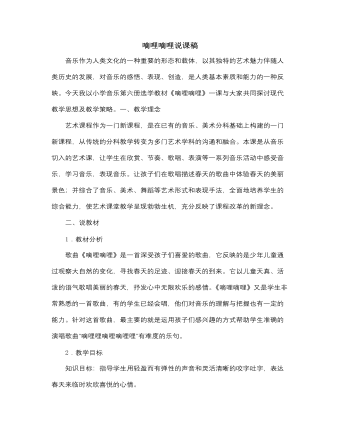
人音版小学音乐三年级下册嘀哩嘀哩说课稿
艺术课程作为一门新课程,是在已有的音乐、美术分科基础上构建的一门新课程,从传统的分科教学转变为多门艺术学科的沟通和融合。本课是从音乐切入的艺术课,让学生在欣赏、节奏、歌唱、表演等一系列音乐活动中感受音乐,学习音乐,表现音乐。让孩子们在歌唱描述春天的歌曲中体验春天的美丽景色;并综合了音乐、美术、舞蹈等艺术形式和表现手法,全面地培养学生的综合能力,使艺术课堂教学呈现勃勃生机,充分反映了课程改革的新理念。二、说教材1.教材分析歌曲《嘀哩嘀哩》是一首深受孩子们喜爱的歌曲,它反映的是少年儿童通过观察大自然的变化,寻找春天的足迹、迎接春天的到来。它以儿童天真、活泼的语气歌唱美丽的春天,抒发心中无限欢乐的感情。《嘀哩嘀哩》又是学生非常熟悉的一首歌曲,有的学生已经会唱,他们对音乐的理解与把握也有一定的能力。针对这首歌曲,最主要的就是运用孩子们感兴趣的方式帮助学生准确的演唱歌曲“嘀哩哩嘀哩嘀哩哩”有难度的乐句。
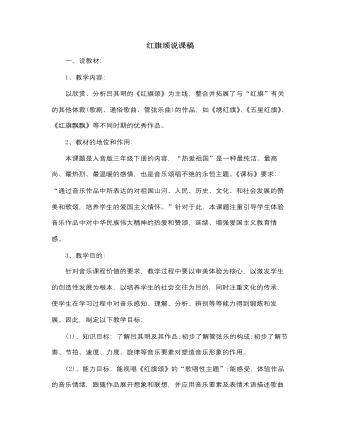
人音版小学音乐三年级下册红旗颂说课稿
⑹、完整听赏《红旗颂》。思考:你能感觉到音乐情绪发生变化了吗?请用手势示意。请学生听辨出①号角主题、②歌唱性主题、③进行性主题,并在聆听过程中用手势示意,强化学习的目标,增强对作品的理解和感受。5、课堂小结:比较相同主题(红旗)不同体裁(歌曲、乐曲)的表演风格特点。相同点:都能以真挚的情感打动人的心灵,引发内心的共鸣。不同点:歌曲--动听的旋律,动人的歌词,动情的演唱,使得歌曲在表达音乐情绪,刻画音乐形象上更容易让人理解和感受。乐曲--丰富的和声,多层次的配器,大型的管弦乐队,使得乐曲在表达上更到位,更有层次,更感人肺腑,得到的感受更深刻难忘。6、布置作业:课后唱背红旗主题,尝试为红旗主题填上合适的歌词并演唱出来,下节课同学之间交流一下,比一比谁的创作更精彩。
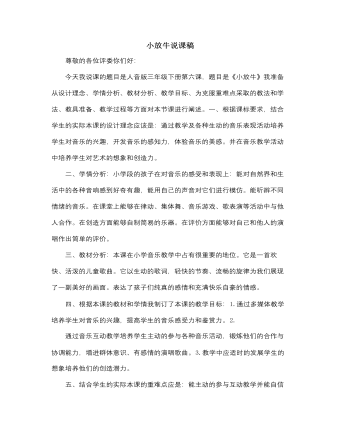
人音版小学音乐三年级下册小放牛说课稿
有感情就有想象,从而形成创造思维。老师可依据本课的内容及情绪鼓励引导学生进行即兴创编活动。充分挖掘学生的潜力。创编一些与课本情绪一致的节奏、诗歌、故事、游戏、音乐表演等。(创编的内容和形式可以根据教材而定)根据学生的个性差异对每一位同学都应该多关心多鼓励。构建和谐团结民主的氛围。引导学生积极讨论共同参与,培养学生乐观的学习态度和友爱的精神。锻炼合作与协调能力,增进群体意识,培养团队精神。第五环节:自评互评培养鉴赏力本课的教学评价我是以表扬和鼓励为主,随时引导学生在音乐活动中开展自评互评和老师的随堂评价,以提高学生的乐感和审美能力。我评价他们的重点是能否积极自信的参与音乐表现、能否与其他的同学协作配合、在课堂小结时我还安排了学生谈一谈这节课的感想如:这节课你学到了什么?歌曲中你最喜欢那一句?在课堂上对那些有创意的学生我还及时的发给他们小奖品。小结:以上是本课的总阐述,不到之处请评委指正。
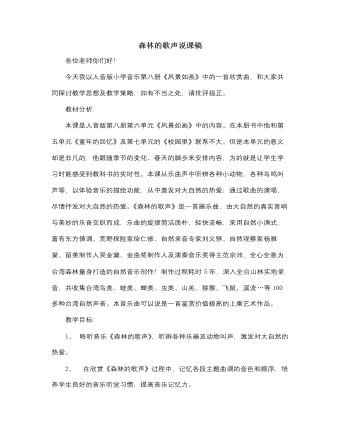
人音版小学音乐四年级下册森林的歌声说课稿
6、然后模唱《森林的歌声》中的三段主旋律,并通过模唱、模仿乐器演奏等方式分别熟悉三段旋律。7、乐曲当中的三段主旋律的听辨,是本节课的重难点,所以我通过各种方式让学生去熟悉,如:模唱、表演唱等,让学生通过不同的形式去熟悉各段主旋律。由于这三段旋律情绪上的区别不是很大,所以学生比较容易混淆,所以所以我采用让学生动笔记录音乐的方式,来更准确的区分音乐。8、紧接着老师介绍这么美丽动听的音乐来自大森林,可是人们却不珍惜它,用幻灯片展示一组人们乱砍乱筏,肆意掠杀动物的图片。激起学生内心的对坏行为的愤怒,也唤醒学生保护环境的意识。9、老师带领学生用自己的方式来尽一份力,来呼唤更多的人保护环境。老师把本节课的3歌主题加入歌词,请学生来演唱、录音,来宣传保护环境,呼吁人们留住美好的大森林。
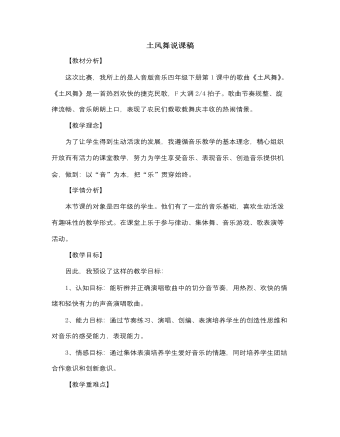
人音版小学音乐四年级下册土风舞说课稿
通过观察比较,让学生发现歌谱中的力度记号,如:重音、渐强、渐弱记号等,从而跟好的演唱歌曲,提高学生的审美能力。四、创编表演,体验情感通过视频让学生了解土风舞的舞蹈动作特点,再由小组讨论创编,为我们今天所学唱的歌曲创编出属于自己的土风舞动作。此环节的进行,让全体学生都能参与到音乐实践当中,让学生能自信地唱、大胆地编、尽情地演,感受音乐带给人们无比的快乐,学生的主体性和创造性得以充分的体现。五、总结评价,收获快乐本课的教学评价我是以表扬和鼓励为主,随时引导学生在音乐活动中开展自评互评和老师的随堂评价,以提高学生的乐感和审美能力。我评价他们的重点是能否积极自信的参与音乐表现、能否与其他的同学协作配合、在课堂小结时我还安排了学生谈一谈这节课的感想如:这节课你学到了什么?你觉得自己今天表现的怎么样?
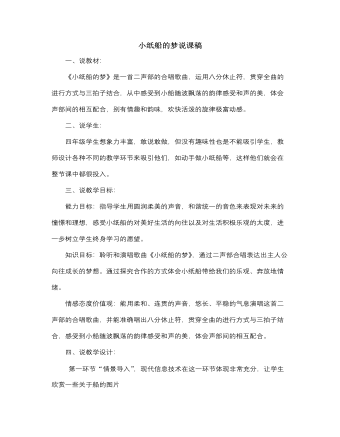
人音版小学音乐四年级下册小纸船的梦说课稿
第一环节“情景导入”,现代信息技术在这一环节体现非常充分,让学生欣赏一些关于船的图片第二环节“反复感受,轻松学歌”,音乐是听觉的艺术,在这一环节中,我首先让学生通过反复聆听来感受这首歌曲,接着采用模唱法和听唱法相结合让学生在轻松愉快的氛围中学会了本课歌曲。第三环节“表现歌曲”这是本课中最出彩的一个环节。在前面的几个环节中层层铺垫,为学生积累了很多艺术实践和经验,这时让学生拿着自己的船进行音乐表现,学生已经没有困难,而且能够表演得很到位,将整堂课推向高潮。最后的拓展部分引发学生对祖国热爱,激励他们努力学习而使学生喜欢音乐,感受音乐带给我们的美以及对未来的憧憬和理想。让他们在以后的学习生活中能奋发向上!
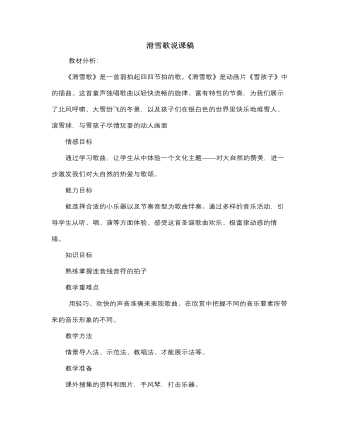
人音版小学音乐六年级下册滑雪歌说课稿
教材分析:《滑雪歌》是一首弱拍起四四节拍的歌。《滑雪歌》是动画片《雪孩子》中的插曲。这首童声独唱歌曲以轻快流畅的旋律、富有特性的节奏,为我们展示了北风呼啸、大雪纷飞的冬景,以及孩子们在银白色的世界里快乐地堆雪人、滚雪球,与雪孩子尽情玩耍的动人画面情感目标通过学习歌曲,让学生从中体验一个文化主题——对大自然的赞美,进一步激发我们对大自然的热爱与歌颂。能力目标能选择合适的小乐器以及节奏音型为歌曲伴奏。通过多样的音乐活动,引导学生从听、唱、演等方面体验、感受这首圣诞歌曲欢乐、极富律动感的情绪。知识目标熟练掌握连音线音符的拍子教学重难点用轻巧、欢快的声音准确来表现歌曲。在欣赏中把握不同的音乐要素所带来的音乐形象的不同。教学方法
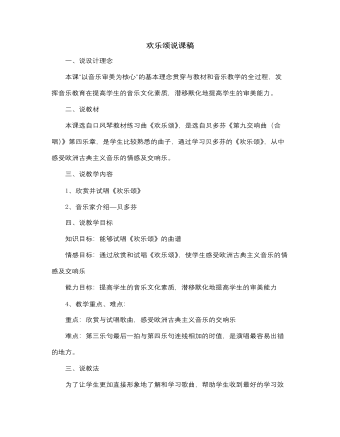
人音版小学音乐六年级下册欢乐颂说课稿
2、视频欣赏进入重点突破难点a、在这个环节我会播放电脑课件,让学生视听欣赏本曲,引导学生在参与欣赏音乐的活动中探索发现,深化情感体验。这是本课的重点。b、视听之后让学生用跟唱法学习歌曲,用“la”模唱,由于这首歌曲调很单纯,4/4拍子,所以学生完全有能力独立学会它。但能够完全无误地演唱好歌曲第三乐句最后一拍与第四乐句连线相加的时值便是本曲要突破解决的难点。在这个地方我会乐曲重复播放,利用电脑直接点击循环再现,为课堂省下不必要浪费的时间。这个环节我会对学生演唱歌曲进行检测,看是否已经解决了难点。方法有:A.全班同学或分组模唱B.个别模唱难点旋律C.难点旋律数、打拍子3、曲谱的试唱试唱曲谱强化学生听觉训练。美国作曲家、音乐教育家艾伦?科普兰说:“如果你要更好地理解音乐,再也没有比倾听音乐更重要的了。”
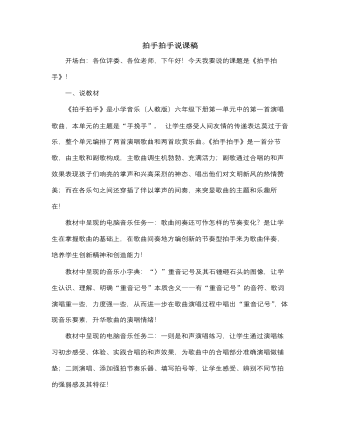
人音版小学音乐六年级下册拍手拍手说课稿
全体四人小组讨论编创间奏节奏变化,并进行练习!(巡视引导)之后,全体同学集中汇报各自小组的编创成果,如下:(1) X —(2) X X X其余同学评价该组的编创成果全体学生随乐用新的间奏节奏型拍手演唱歌曲(播放音乐)创造是发挥学生想象力和思维潜能的音乐学习领域,引导学生进行即兴式探究创造活动,是学生积累音乐创作经验和发掘创造思维能力的过程与方法。今天这节课,你有哪些学习收获?学生就会提出自己的收获,如:学会了这首歌曲《拍手拍手》,认识了“﹥”,知道了朋友间的友谊、友情是可以通过掌声来传递的……等等!引导学生对自己学习情况进行梳理和小结,明确各自在当堂课中的音乐学习信息,来促进今后的音乐学习质量和效率的提升!六、说板书我的板书设计是根据教学中需要和学生交流的关键知识点设计的,便于学生在总结学习收获时,梳理自己的音乐学习信息,明确学习重难点,并加深学习印象!
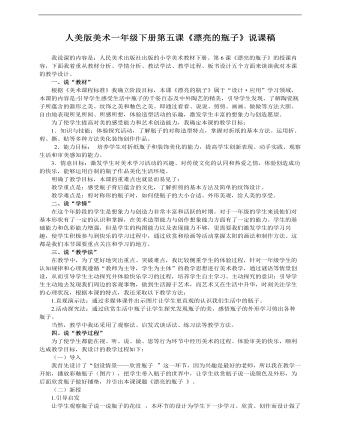
小学美术人美版一年级下册《漂亮的瓶子》说课稿
1.知识与技能:体验探究活动,了解瓶子的对称造型特点,掌握对折纸的基本方法。运用折、剪、撕、贴等多种方法美化装饰创作作品。 2.能力目标: 培养学生对折纸瓶子和装饰美化的能力,提高学生创新表现、动手实践、观察生活和审美感知的能力。3.情意目标:激发学生对美术学习活动的兴趣、对传统文化的认同和热爱之情,体验创造成功的快乐,能够运用自制的瓶子作品美化生活环境。明确了教学目标,本课的重难点也就显而易见了:教学重点是:感受瓶子背后蕴含的文化,了解折剪的基本方法及简单的纹饰设计。教学难点是:剪对称形的瓶子时,如何使瓶子的大小合适、外形美观,给人美的享受。
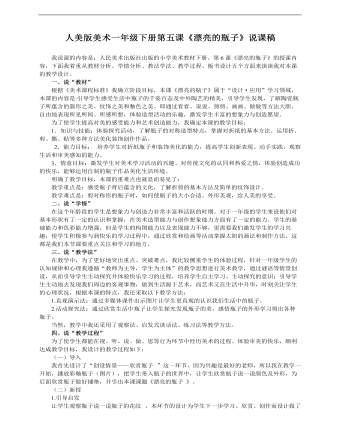
小学美术人美版一年级下册《6漂亮的瓶子》说课稿
1.知识与技能:体验探究活动,了解瓶子的对称造型特点,掌握对折纸的基本方法。运用折、剪、撕、贴等多种方法美化装饰创作作品。 2.能力目标: 培养学生对折纸瓶子和装饰美化的能力,提高学生创新表现、动手实践、观察生活和审美感知的能力。3.情意目标:激发学生对美术学习活动的兴趣、对传统文化的认同和热爱之情,体验创造成功的快乐,能够运用自制的瓶子作品美化生活环境。明确了教学目标,本课的重难点也就显而易见了:教学重点是:感受瓶子背后蕴含的文化,了解折剪的基本方法及简单的纹饰设计。教学难点是:剪对称形的瓶子时,如何使瓶子的大小合适、外形美观,给人美的享受。
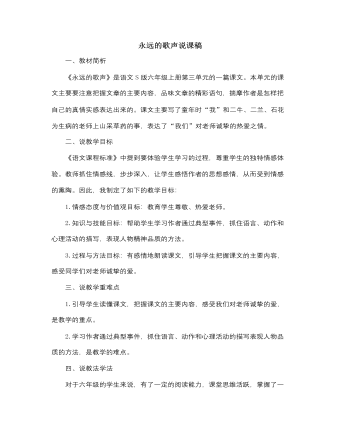
人音版小学音乐三年级下册永远的歌声说课稿
五、说教学过程为了完成本节课的教学目标,我设计了以下教学过程。1.激情导入,质疑课题首先,教师唱《小放牛》,以童年的歌声引入课文,激发学生的兴趣。同学们,走出山乡、走出童年已经很久了,真的很久很久了。童年像一幅褪了色的画,贴在记忆迷离的墙壁上,好些地方都淡得看不出线条和色彩来了,而童年的一些歌却如那山间淙淙的小溪,清亮亮地流淌着,至今仍想在我的耳边,我的耳边又响起了那永远的歌声。(板书课题:永远的歌声)接着,提出问题,为什么作者以“永远的歌声”为题?歌声里包含着什么?这两个问题也是本节课的主线,接下来的教学环节都将围绕这两个问题进行。2.初读课文,理清文章的脉络自由朗读课文,想一想课文主要讲述了一件什么事情?